Sealing the Envelope
Designing high-performance building envelopes with expansive glass spans
![]() Continuing Education
Continuing Education
Use the following learning objectives to focus your study while reading this month’s Continuing Education article.
Learning Objectives - After reading this article, you will be able to:
- Compare and evaluate the characteristics of curtain walls, window walls, and storefronts.
- Glean best practices for properly designing, detailing, and sealing a building enclosure with large expanses of glass.
- Review enclosure designs for optimized thermal performance; air, water, and moisture protection; and mitigating condensation.
- Understand how to design building envelopes for structural resiliency, enhanced acoustics, and fire protection.
As energy-efficient, daylit, sustainable buildings continue to gain traction, interest in glass facade designs is growing in tandem.
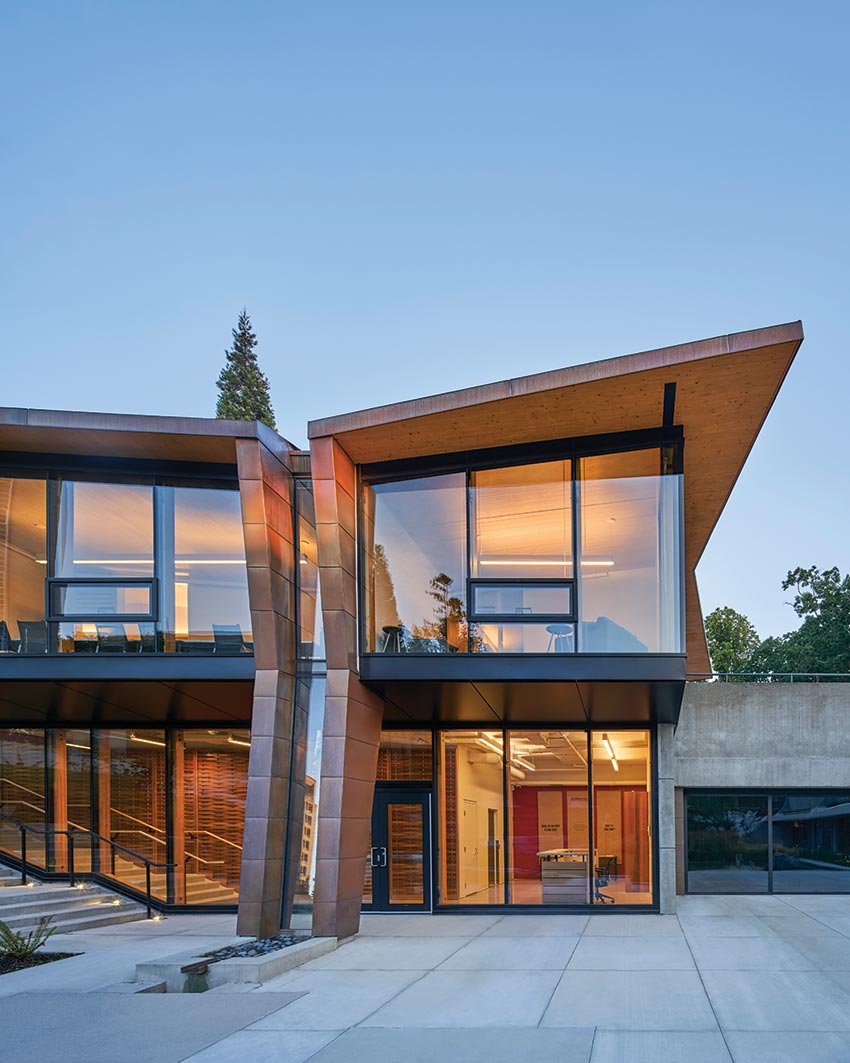
Photo: Andrew Latreille
At the Indian Residential School History & Dialogue Center in Vancouver, British Columbia, an all-glass design with a tight thermal building envelope delivers high energy efficiencies.
“Glass is an amazing material. It is strong, it can be made in very large panels, and it can be curved or formed into complex shapes,” relates Damian Rogan, BSc, MSc, CEng, MIStructE, director of facade engineering, Eckersley O’Callaghan, London. “But its most appealing property is its transparency.”
Similarly, Linda M. McGowan, PE, AIA, BC&E, Littleton, Colorado, sees a desire to bring the outdoors inside as driving interest in “relatively large areas of glazing with relatively small frame sections.”
“Glass walls offer clean, simple lines and are often employed to express transparency and lightness from both visual and daylighting standpoints,” adds Eric Schroter, principal at Simpson Gempertz & Heger, San Francisco. “Glass facades can also give the appearance of physical lightness.”
While expansive glass spans are appealing for their aesthetics, daylighting, views, and modern look, ensuring a tight building enclosure is key to energy performance, environmental air quality, and longevity. It’s All in the Envelope.
Honing in on the enclosure itself, in its “Guide for Designing Energy-Efficient Building Enclosures,” RDH Building Engineering describes the building envelope as a system of materials, components, and assemblies that physically separate the exterior environment from the interior environment.
Ultimately, the enclosure must perform a long list of important jobs, including thermal and structural performance; air, water, and condensation resistance; sound attenuation; fire safety, security, and more. In addition to executing all these roles, the most prominent is its post as the building entrance. Consequently, the facade must present a beautiful, striking design and make a great first impression to visitors as they enter.

Photo courtesy C.R. Laurence
A high-performance, triple-glazed curtain-wall system clads Mountain Equipment Co-op’s four-story headquarters in East Vancouver, Canada.
As delineated in Auckland, New Zealand’s Design Manual, the enclosure “has the important functional role of ensuring internal spaces are healthy and pleasant environments for the inhabitants, as well as contributing to the image and character of the building within the public realm.”
Along these lines, Chris Arnold, FAIA, RIBA, former building systems development principal, now retired, explains in his Whole Building Design Guide (WBDG) article “Building Envelope Design Guide – Introduction” that the powerful role of aesthetics on the envelope was the driving factor of the development of the curtain wall.
“Since the first all-glass skyscrapers were sketched by Mies van de Rohe in 1919 and 1921, architects strove to achieve ever simpler and purer glass forms,” he writes.
It was post World War II that curtain walls began appearing in some European buildings, but the most significant development took place in the United States over that period.
“First designed as an expensive, refined, and elegant custom artifact, it gradually became a standard commodity and today is the least costly way to enclose a structure,” Arnold explains. “Perhaps more important, for several decades, the glass box perfectly symbolized, in its image of contemporary elegance and modernity, the aspirations of American corporate architecture from Wall Street to Main Street.”
Offering some perspective, Scott Slarsky, director, Shepley Bulfinch, Boston, adds, “The emergence of the curtain wall in the early 20th century transformed the manner in which architects began to understand the use of glass in the facade of a building.”
Another noteworthy aspect of building enclosures is the fact that for a multistory building, the envelope can exceed 20 percent of the total construction cost, making it even more critical to invest wisely in design, detailing, and construction.
“The success of the building envelope depends upon the selection of appropriate materials and components, and how these are brought together,” states the Auckland Design Manual.
Building the Enclosure
Within the realm of glass facade systems, curtain walls, window walls, and storefronts can be evaluated to determine which is the best choice based upon the project parameters.
Offering a little more history on the emergence of the curtain wall, Slarsky explains that historically, glass was used primarily as an insertion into a masonry, stone, or wood wall to deliver natural light to the building interior. Limited by the technology of the time, the glass windows were only capable of reaching a certain size and were therefore referred to as punched openings in the surface of an opaque wall.
Today, not only has technology advanced to support very large glass units, but the latest insulated units, glazing materials, coatings, and gas-filled spaces can also overcome the code challenges of designs with larger window-to-wall ratios.
In terms of what’s driving a strong interest in curtain walls, Dr. Helen Sanders, president of the Facade Tectonics Forum, believes it is the design flexibility afforded to architects and the market’s desire for transparency, access to daylight, and breathtaking views.

Photo: Geoff Captain
At The Elysian in Los Angeles, a 20-foot floor-to-ceiling thermally improved curtain wall system delivers high thermal efficiencies.
Regarding the former, she explains that the aesthetic choices available in glass—and the opportunity for matching spandrel areas—offers significant design flexibility for architects to achieve their design intent, from high transparency neutral glass to more absorptive and reflective options in a multitude of exterior colors.
Along with a myriad of colors, designers can incorporate a variety of patterns, coatings, and materials into their curtain-wall designs, as well as accessories such as sun shades and light shelves to help mitigate solar gain and glare issues.
As for the latter driver, “the opportunity for floor-to-ceiling glass also provides the market with highly desired views and interiors with open and transparent aesthetics, which are now synonymous with premium properties,” she relates.
Based on his 50 years in the industry, Richard Keleher, AIA, CSI, LEED AP, senior architect, The Thompson & Lichtner Company, Canton, Mass., observes that the curtain wall’s popularity is due to the fact that it’s the current design aesthetic driven by schools of architecture. Furthermore, it’s easier to delegate the whole facade to one trade because there are far fewer details to manage. Similarly, contractors prefer to delegate coordination and pricing responsibility to one source.
Curtain Walls, Window Walls, and Storefronts
In terms of the differences between curtain and window walls, curtain walls are attached to the building structure, self-supporting, and portray an expansive, uninterrupted glass appearance. For window walls, glazing is placed between a building’s concrete slabs, using the slabs as structural support. The system has a break between the glass, and slab edge covers are used to conceal the concrete.
With fewer mullions and joints required, as compared to most window wall systems, curtain-wall systems act as a single unit and are therefore more resistant to air and moisture penetration. They also deliver excellent structural integrity, require little maintenance, and are typically used in commercial buildings.
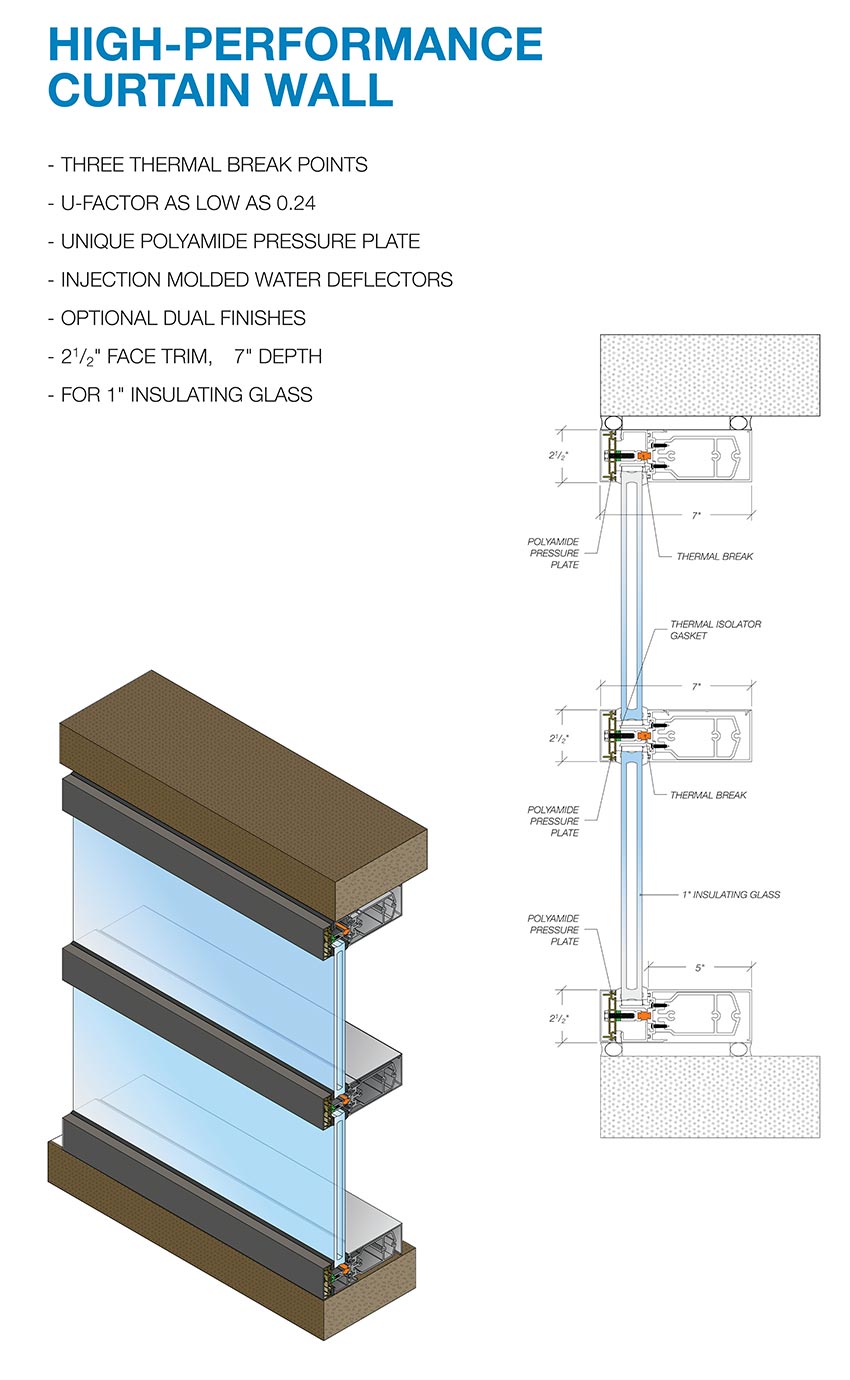
Image courtesy of C.R. Laurence
This high-performance thermal curtain-wall detail incorporates three thermal break points and a unique polyamide pressure plate.
At the same time, the cost of curtain walls can run approximately twice as much as window walls, and installation is a complex process typically involving cranes or rigs to hoist the pieces from the building exterior.
Because window walls contain more repeatable components, they can be prefabricated in the shop to a greater extent, enabling fewer errors, less site disruptions, and a higher-quality product. The product also requires less engineering and incorporates more natural fire protection as the exterior wall is broken up by each floor’s concrete slab, which provides fire stopping. The separation of each window wall unit creates a sealed space with less noise transfer and energy loss.
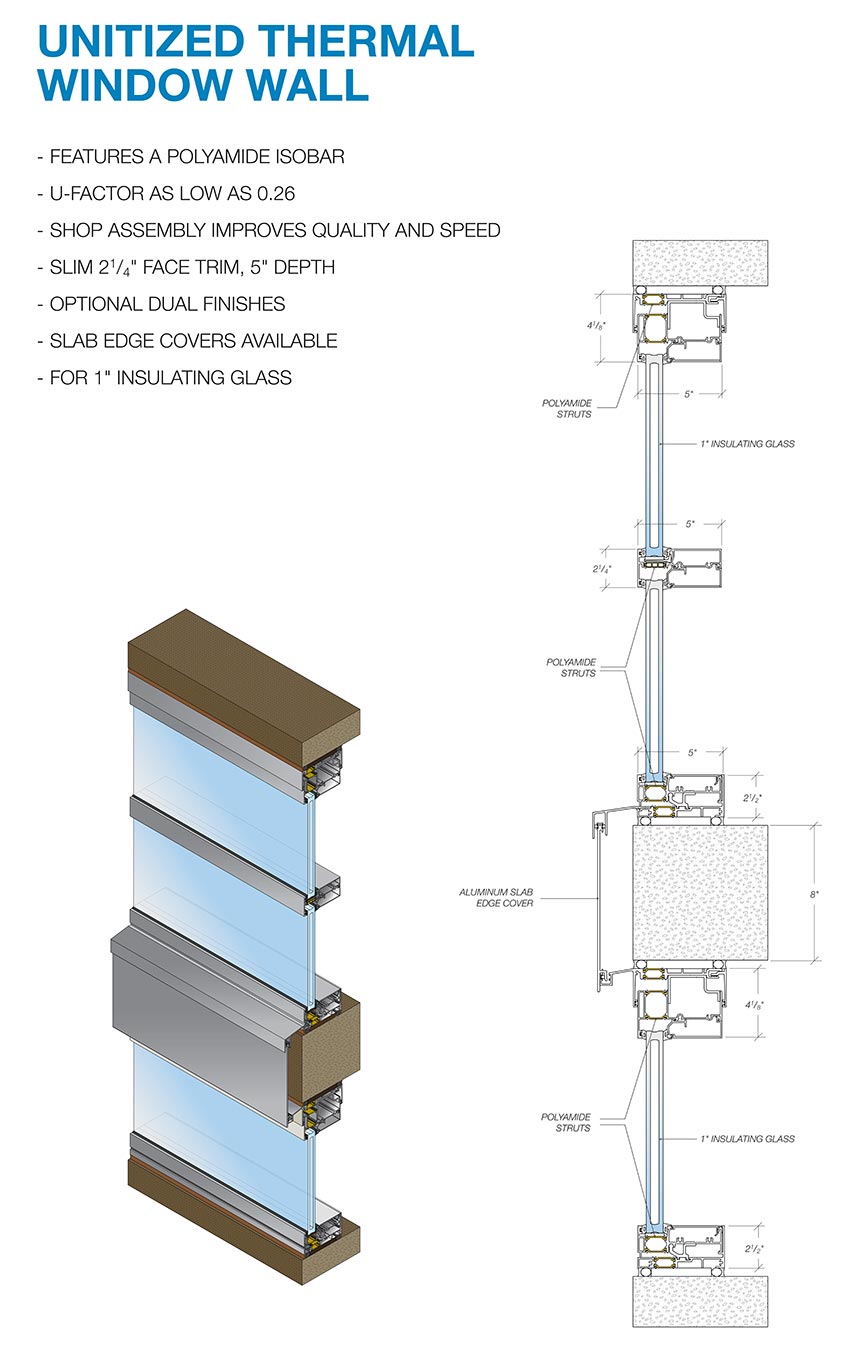
Image courtesy of C.R. Laurence
This high-performance thermal window wall features a polyamide isobar.
Throwing storefronts into the mix, although typically limited to frame heights of up to 10 feet, these glazed systems are suitable for smaller commercial applications. In most cases, they’re used on the ground floor of a building, but they can also be designed for second floors. Storefronts are typically center glazed and not self-draining. While frame heights and building heights will go a long way in determining whether a storefront or curtain wall is most suitable for a given project, other factors include wind pressure, inter-story drift, floor movement, allowable deflections, vertical mullion spacing, and anchor points.
Unitized vs. Stick Built
Another option with curtain walls is selecting a unitized or stick system. In a stick system, the curtain-wall frame (mullions) and glass or opaque panels are installed and connected together piece by piece. In the unitized system, the curtain wall is composed of large units that are assembled and glazed in the factory, shipped to the site, and erected on the building. Vertical and horizontal mullions of the modules mate together with the adjoining modules. Modules are generally constructed one story tall and one module wide but may incorporate multiple modules. Typical units are 5–6 feet wide.
According to Ignacio Fernandez Sola, associate director, Arup, who writes in a LinkedIn article “Unitized vs. Stick: When and Why,” the main variables include the total facade size, degree of repetition, shape and dimensions, planarity, and allowance for structural movement.
Facade size: The larger the size, the more suitable option is unitized. Giving a rule of thumb, Sola advises unitized for more than 5,000 square meters, and stick if the facade is less than 3,000 square meters, as there isn’t not enough space to achieve the economy of scale to justify unitized.
Degree of repetition: If the floor height is constant and the distance between mullions is repetitive, then breaking the facade into units of a similar size—as is the case with unitization—and prefabricating them in the factory makes sense.
Shape and dimensions: Taller buildings above six floors are more suitable for unitized systems, but a low, extended building is a better fit for stick.
Planarity: If dealing with flat, vertical walls, the on-site assembly of a stick system will be best. But once slope, three-dimensional slopes, and the like are added, the preference shifts to unitized. According to Sola, the same applies for penetrations. The more brackets required for external sunshades, for instance, the more prefabrication is favored.
Allowance for structural movements: If the project is in a seismic zone and/or if shear or floor-to-floor movements are to be expected, then the ideal choice is unitized.
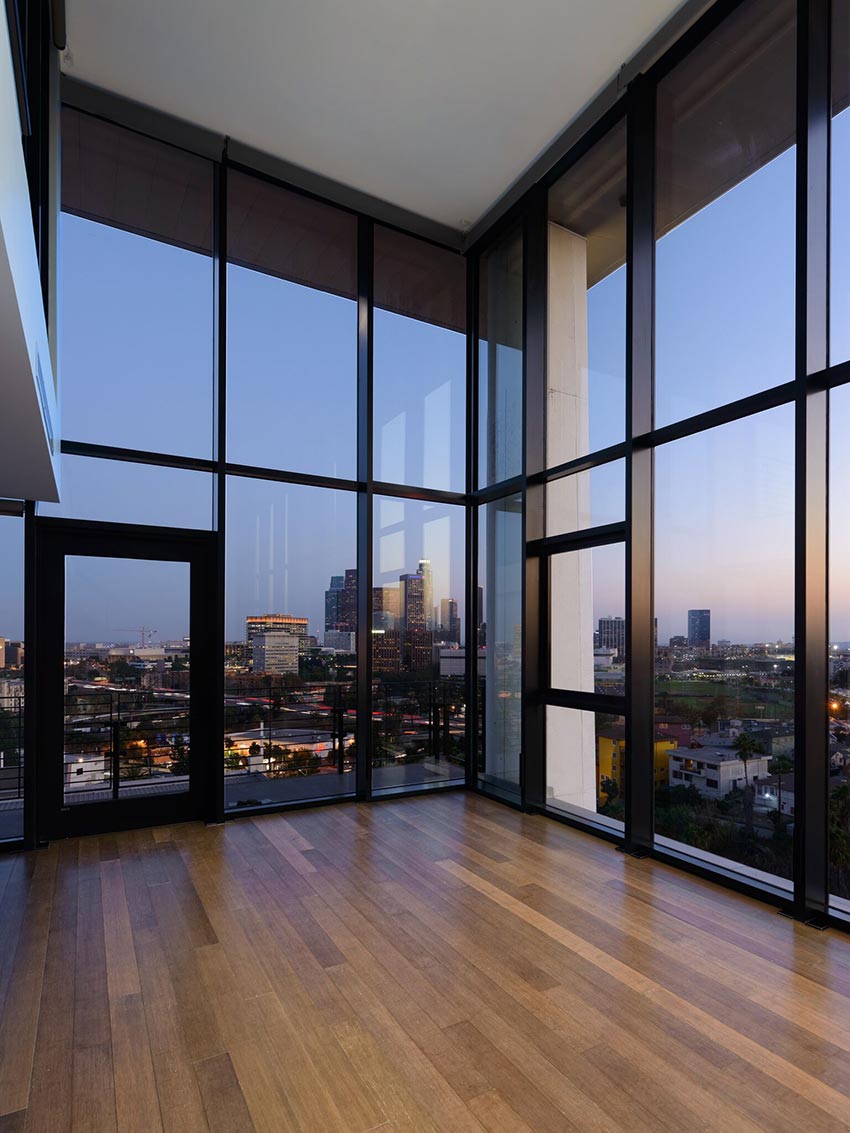
Photo: Geoff Captain
A stick-built curtain-wall system affords Elysian residents a beautiful view of the Los Angeles skyline.
Glass Selection
In order to improve the thermal performance of the glass units in the facade, double or triple glazing is recommended.
With double-glazed technology, an inert gas is encapsulated in between the two glass panes. The argon allows sunlight to pass through while limiting the level of solar energy that escapes from the glass.
In a triple-glazed configuration, there are two argon-filled cavities inside three panes of glass. The result is better energy efficiency and sound reduction along with less condensation, as there is a smaller temperature differential between the interior and the glass. While higher performing, triple glazing is a more expensive option.
For enhanced durability, laminated glass is made with a polyvinyl butyral (PVB) interlayer. Laminated glass offers a number of benefits, including blocking ultraviolet-light transmission, better acoustics, and perhaps most notably, holding together when shattered.
Segueing into the issue of building impact and blast resistance, the building exterior functions as the first line of defense against projectiles. Consequently, the way the facade responds to an impact will significantly affect what happens to the structure. Granted, it’s difficult to prevent the glass from breaking after a significant impact, but laminated glass, or an anti-shatter film applied to existing glazing, will better contain the shards of glass to protect building occupants from the debris.
But more than just containing the shattered glass, curtain-wall performance in response to to a blast is dependent upon the interaction between the capacities of the various elements.
“In addition to hardening the individual members that comprise the curtain-wall system, the attachments to the floor slabs or spandrel beams require special attention,” writes Robert Smilowitz, Ph.D., SECB, F.SEI, senior principal, Protective Design & Security, Thornton Tomasetti – Weidlinger, New York, in WBDG’s “Designing Buildings to Resist Explosive Threats.”
“These connections must be adjustable to compensate for the fabrication tolerances and accommodate the differential inter-story drifts and thermal deformations as well as be designed to transfer gravity loads, wind loads, and blast loads,” he writes.
Thermal Performance
While the roles of the building enclosure are varied and many, the facade’s thermal performance levels loom large in today’s environment of sustainable designs and increasingly stringent codes and standards.
Traditionally, glass has been the weak link in the chain, notably decreasing the facade’s overall insulating R-values, no matter how well insulated the other cladding and connecting elements.
“Heat loss and heat gain through large areas of glazing are some of the more significant performance challenges, particularly in high-altitude and alpine climates, along with controlling glare,” states McGowan.
Consequently, high-quality thermal breaks, which work to eliminate the thermal bridges through which cooling and heating energy freely pass, are absolutely essential.

Photo: Geoff Captain
At the 777 Aviation office building in El Segundo, California, a structural silicone-glazed curtain wall utilizes a polyurethane thermal break and injection-molded thermoplastic connector that joins interior and exterior members to deliver total thermal isolation.
In terms of energy codes in general, experts anticipate that California’s stringent Title 24 will be setting the standard moving forward and that many states will follow its lead.
As for what this means in practice, Matt Williams, associate principal and facade engineering leader, Arup, Los Angeles, explains that a prescriptive, code-based approach to Title 24 is predicated on a 40 percent window-to-wall ratio (WWR), which allows the non-vision or opaque areas of the facade to have a higher, better-performing thermal transmittance to counteract the lower performance of a glass facade. “Where facades have a higher WWR, with more transparency or vision areas, the opaque or spandrel areas need to perform even better to balance the reduced performance of the larger glazed areas.”
In order to provide the proper documentation for compliance, building teams will need to rely upon energy consultants and manufacturers. In addition, glazing systems suppliers, with the use of project-specific National Fenestration Rating Council Bid Reports, will need to ensure that the systems being specified meet code requirements.
Along these lines, Ronald Wooten, FMPC, director of product testing and certification, C.R. Laurence, Los Angeles, cautions against assuming that manufacturer-published thermal performance data applies to all comparable systems in a given project.
Similarly, most curtain-wall and storefront manufacturers publish best-case, center-of-wall data, but even though the same system may be used throughout the facade, the performance values can vary considerably based upon configuration or elevation.
It’s also important to note that code requirements for renovations will vary significantly from locale to locale. For example, Title 24 requires that prescriptive U-factors be applied to all alterations or additions to existing buildings, regardless of size. However, solar heat gain and visible transmittance requirements only take effect when 150 square feet or more of the fenestration is altered.
Ultimately, to keep up with these ever-changing code requirements, Paul Worthington-Berry, AIA, associate, Shepley Bulfinch, Boston, requests that manufacturers incorporate new components and materials into their systems.
Rising to the challenge, newer curtain-wall systems have two thermal breaks and incorporate thermal separators rolled into the aluminum extrusions. Furthermore, some manufacturers have added advanced plastic materials to create continuous thermal breaks in vertical and horizontal mullions to provide optimal thermal performance.
Another newer innovation uses ultra-thin glass as the inner layer of triple pane glazing. The product is much lighter so it can be used in a conventional frame and is therefore more affordable.
Furthermore, polyamide thermal breaks and insulating glass units with warm-edge spacers significantly reduce heat transmittance compared to traditional curtain walls. Curtain walls and window walls that incorporate metal panels or spandrel panels with insulation can also mitigate thermal bridging at building slab edges.
Another strategy for enhancing thermal performance is incorporating some insulation into the glazed wall assemblies via shadow boxes and insulated back pans, which can give the exterior appearance of an all-glass facade; although the trade-off is a more limited actual vision area, according to Schroter. In determining if the design will meet thermal requirements, Rogan says his firm utilizes analysis tools that can directly import their drawings and carry out thermal calculations and condensation checks. “This ensures our engineers find and solve the weak points in their designs before they are fabricated.”
Air, Water, and Moisture Protection
While the curtain-wall glass, opaque filler panels, and supporting frame function as basic air-barrier materials, the details of the interface of the glazing system with the opaque wall assembly is the most critical part of the design, explains George Blackburn III, AIA, BCxA, Blackburn Architecture, Carrollton, Texas. The second priority is specifying effective performance verification testing for air leakage of the wall assembly.
Ultimately, the continuity of the glass panel through the air seal is critical to the continuity of the air barrier.
In addition to air barriers, vapor barriers, flashings, and sealants must all be carefully detailed to work in concert with curtain-wall systems.
“It helps to have multiple envelope components manufactured by a single source,” states Worthington-Berry. “This insures that these systems have been time-tested to provide compatibility and performance. Working with a single-source supplier allows the architect to collaborate with them on critical details.”
In terms of what to look for to ensure a tight enclosure, Schroter notes that transition detailing—not to mention facade system material interfaces, corners, and terminations—are often the most critical and a sometimes overlooked component in successful facade performance. Consequently, it’s important to evaluate how and where the air, water, and vapor barriers are employed in all adjoining assemblies to ensure consistent detailing, continuity, and material compatibility.
“Water infiltration systems for the building envelope follow the principle of overlapping or cascading elements that drain or weep any moisture out of the system through gravity,” explains Williams.
As a simple test, Blackburn recommends drawing with a pencil along the air, water, and thermal barriers to practically see if there is continuity.
“Where curtain walls often fail is at the interfaces with adjoining building elements,” agrees Rogan. “These interfaces should always be the focus of architects and engineers in the design stage, but it’s also important that general contractors assign responsibility for the interface with one of the trade contractors carrying out the work. We find it useful to color-code our drawings indicating the watertightness line and the airtightness line, so it’s easier for the trade contractors to understand how to properly interface between systems.”
He adds that air, water, and moisture performance should be tested off-site prior to installation. By minimizing the need for applying wet sealant on-site, the project team is less reliant on field workmanship, which is important, as sites can be wet, windy, dirty places where it is difficult to manage quality.
To help support tight enclosures with curtain walls, specifiers recommend pressure-equalized systems with interconnecting gaskets or wet seals to deliver the needed weather barrier continuity.
“This allows the pressure-equalization chambers to eliminate outside forces upon water infiltration and enable the curtain wall to perform as a high-performance rainscreen,” Worthington-Berry explains.
Another challenge with all-glass facades is dealing with the floor-line exterior air and interior smoke seals. Offering some advice, Schroter suggests placing unitized wall assembly stack joints at or slightly above the floor line and providing a back-sealed backpan filled with curtain-wall insulation to best maintain the floor-to-floor closure.
“The floor line smoke and interior air seals can be sealed to the face of the slab, the backpan, or the foil-faced insulation to ensure the visual continuity of the exterior glass at the floor line while maintaining the floor line seals,” he explains. “Interior ‘false’ mullions can be used to provide a horizontal closure for the backpan while allowing the glass to continue vertically uninterrupted across the facade at the floor lines.”
Keleher shares the following technical best practices for optimal water and moisture protection in curtain walls:
- Specify pressure-equalized and compartmented systems and silicone or PVC zone dams with silicone sealant.
- Cope the end portion of the pressure plate screw spline at the perimeter of curtain-wall framing members to allow for the installation of continuous sheet membrane flashing. Use exterior-glazed system to allow for inspections and connection of the air and water barrier into the glazing pocket.
- Bring the adjacent weather-barrier membrane into the glazing pocket. Cope the ends of pressure plate screw splines at the top and bottom of vertical mullions to allow continuous installation of membrane flashing into the glazing pocket. Do not just seal between the curtain-wall tube and the adjacent jamb as is typically shown on manufacturers shop drawings.
- If the above is not possible, avoid “F” anchors, and cap top and bottom of vertical mullions.
- Provide end caps on snap covers so that secondary sealant has a surface to adhere to, if sealant is shown to be adhered to snap covers.
- Design three weep holes in each horizontal pressure bar: two outside of the setting blocks and one between them, per the Glass Association of North America, unless the setting blocks are designed to pass water.
- Use backpans for spandrels and metal panel and stone panels. Leave a ¼-inch gap for warm indoor air. Insulation should be on five sides of the backpan, stopping 1-inch from the glass.
- Each glazing cavity should be compartmented and separately weeped (with water and insect-resisting baffles) through the horizontal pressure plates to the space behind the snap covers and outside via weep slot holes in the bottom of the snap covers.
Honing in on the parapet interface, Keleher notes that at the point where the curtain wall “flies by” (i.e., extends past the roof system to create a parapet), thermal issues can be significant. “Careful design by a building enclosure consultant and equally careful execution by the contractor is necessary to make these designs work.”
For above the curtain wall and out under the soffit, it’s important to ensure that the air, vapor, and thermal barriers are continuous. “Floors over soffits can be very cold in the winter and the source of discomfort for occupants, so use of a closed-cell insulation is important,” says Keleher. “Or, even better, the creation of an interstitial space that is heated to keep the floor slab from getting cold.”
Condensation
At the same time, designers must look for what’s called interstitial condensation, which can occur when water vapor penetrates through an insulated wall and begins to build up on a cold surface. The remedy, says Rogan, is internal air barriers.
Generally speaking, when the surface temperature reaches the dew point, condensation can form on both the interior and exterior surfaces. In addition, high humidity and low temperatures create “microclimate” conditions between glazed wall systems and interior blinds and drapes, leading to the formation of condensation, particularly in cold climates, explains McGowan. “Controlling interior humidity, raising air temperatures adjacent to the glazed wall systems, and allowing for warm, dry air to continually wash the glazing and framing systems are some design strategies for mitigating condensation,” she says.
With curtain walls, the areas most prone to this are on or adjacent to curtain-wall framing members, at penetrations through the glazing assembly such as steel outriggers, or in improperly insulated wall panels with incomplete or mislocated air and vapor barriers, according to Schroter.
Furthermore, the connection to the spandrel areas is a particularly vulnerable area.
“The interior surfaces of the mullions in the spandrel areas will experience a colder temperature than those in the vision areas because the areas behind spandrel panels are not conditioned spaces, and the insulation of spandrel panels is not sufficient enough to effectively transfer heat from outside to inside,” explains Sanders.
In addition to making the window-frame and edge-of-glass performance as high as possible to mitigate condensation in the spandrel areas, Yvon Chiasson, senior building science specialist, Morrison and Hershfield, Burlington, Ontario, at a recent Facade Tectonics Institute, shared the following strategies:
- Don’t allow the vertical mullions to be continuous from vision area to spandrel area by sharing the same vertical member. This may involve double stack joints, or designing the curtain wall with continuous horizontal extrusions and discontinuous verticals, rather than the conventional method of long continuous vertical mullions.
- Improve the insulation behind opaque spandrel areas by ensuring that the exterior-facing surface of the interior mullion has insulation in front of it rather than just adjacent to it.
- Use vacuum-insulating panels in the spandrel areas.
Essentially, the highest risk areas are at or near the slab, at the floor level, and at the ceiling level. The same applies to window walls where a similar “thermal weak point” can be found at the slab edge. The bypass system bridging between window units on either side of the slab provides a means for thermal bridging if not sufficiently insulated.
In addition to the above-mentioned strategies, Sanders relates that contingencies can be implemented regarding HVAC system design and window coverings placement. For example, shades and blinds should be fully retracted rather than kept in a partially lowered position, as this prevents stagnant air from being trapped and increasing condensation risk. Radiators or forced-air heating at the floor level can also be advantageous to encourage warm airflow to the top of the window rather than using air ducts at the ceiling.
“Making sure soffits aren’t installed below the level of the window head is also a strategy that minimizes the possibility of reducing airflow around the top of the window, where condensation risk is highest,” she adds.
As for storefronts, the thermal bridging at the frame and edge of glass are prone to condensation, but an additional risk comes with the installation process. If the enclosure isn’t tight, cold air can leak around the outside of the frame or around the edge of the glass in the glazing pocket, further reducing the interior temperature of the frame.
Consequently, Sanders advises that designers carefully consider how and to what the storefront will be attached to ensure that thermal bridging is minimized.
Structural Performance and Resiliency
Another design parameter that is becoming increasingly more important is resiliency. For glazed systems, this means structural performance.

Photo: Geoff Captain
The facade design for The Elysian meets California’s stringent seismic requirements.
For starters, while glass is a strong material, it is also very fragile. In many cases, this can be addressed by using a laminate interlayer between glass panels so that if one breaks, the entire system isn’t severely compromised.
This is particularly important for high-rise buildings because it protects pedestrians below in the case of glass failure.
On the topic of terrorism, Rogan relates that laminated glass performs extremely well in the event of an explosion, as it is able to break and absorb the energy of a blast before imposing that load onto the supporting building frame.
In terms of accommodating building movement, Jane Galli, AIA, LEED AP, associate, Shepley Bulfinch, Boston, points out that movement increases as building height increases, and this must be understood and accounted for in designs. This includes carefully detailing slot connections at structural points to allow for this movement.
Expansion and seismic joints play a key role in this and in connecting to both the new and existing building facades. “Whether dealing with stick-built or unitized systems, understanding where the curtain wall ends and the seismic joint system begins is a critical consideration for overall performance,” she adds.
Building corners are particularly complex, as they move in two or three directions at once; therefore, part of designing a resilient wall assembly is analyzing expected movement in the curtain-wall system’s corners. According to Schroter, these designs may need to incorporate crumple panels or sacrificial elements that can be repaired after a major structural event.
“Split vertical corner mullions may be employed to accommodate this movement but should be evaluated to ensure they remain engaged during extreme movement events,” he explains.
While the curtain wall will be evaluated for structural performance in an accredited testing laboratory prior to construction, it is equally important that the field performance of the installed product be evaluated during different phases of construction as a quality control measure.
Generally speaking, typical facade components are well documented and can be modelled in analysis software to a high level of detail, explains Williams. But where analysis has its limitations, Arup relies on project-specific testing, such as AAMA 501.6: Design Provisions and Test Methods for Architectural Glass Subjected to Seismic Induced Building Movements.
Fire Safety
For aspects of the building enclosure that must be fire rated—for instance, the floor or floor/ceiling assemblies—it’s important to seal voids created at the intersection of the exterior curtain-wall or floor assemblies with an approved system to prevent the interior spread of fire, instructs Rob Connor, AIA, LEED AP, Shepley Bulfinch, Boston. These systems should be securely installed and tested in accordance with ASTM E 2307: Standard Test Method for Determining Fire Resistance of Perimeter Fire Barrier Systems Using Intermediate-Scale, Multi-Story Test Apparatus. The assemblies should prevent the passage of flame for a time period at least equal to the fire-resistance rating of the floor assembly and prevent the passage of flame and hot gases sufficient to ignite cotton waste.
Additionally, exterior building components in high-rises need to conform to NFPA 285 to ensure that the entire assembly is compliant. This standard tests the fire propagation characteristics of exterior wall assemblies and panels used as components of curtain-wall systems that are constructed using combustible materials.
At the same time, Keleher points out that fenestration does not have the fire-promulgating characteristics of foam plastic insulation and certain facade claddings. So if fire-resistance is required, either sprinklers can be provided on the outside, or steel-framed curtain walls or fire-rated glass can be specified.
Schroter mentions that a fire and smoke seal between all roof slabs and parapets is fundamental to mitigating condensation at the parapet interface.
Accordingly, “the floor line smoke and air seals can be sealed to the face of the slab and to a metal backpan or to foil-faced insulation that spans across mullions. From the exterior, this ensures the visual continuity of the exterior glass at the floor line while maintaining the floor-line smoke seals,” he explains.
“Interior ‘false’ mullions below the bottom of the slab can be used to provide a horizontal closure for the backpan while allowing the glass to continue vertically uninterrupted across the facade at the floor lines,” he continues. “Typically, these nonstandard details will require an evaluation by a fire-protection engineer.”
Meanwhile in the United Kingdom, fire safety is even more of a hot topic in the wake of the Grenfell Tower tragedy in North Kensington, West London, that claimed the lives of 72 people in June 2017. In response, the government has introduced new legislation to limit the amount of combustible material that can be incorporated into facades.
In practice, Rogan points out that it is impossible to eliminate all combustible material from a curtain-wall system, as these systems utilize plastics as thermal breaks and rubber gaskets to control water ingress. However, these can be quantified and proven to be insignificant when considering fire risk.
“What is perhaps more important,” he says, “is to ensure that cavities within facades are detailed to prevent the transmission of flames or hot gases from one compartment to another, undetected. And it’s important to remember that in a fire situation, smoke inhalation is a bigger threat than heat. So in addition to limiting the spread of flame, we need to specify products that don’t give off harmful gases when they burn.”
Acoustics
Ensuring airtight seals in the building envelope is essential and expresses itself in a myriad of beneficial ways including better acoustics.
That said, most best practices center around glazing selection. For example, utilizing a noise-reducing interlayer such as PVB between the glass lites to help prevent sound from penetrating through the system.
“Adding more layers of glass, thickening the individual lites of glass, or adding sound-attenuating infill material can all reduce sound transmission as well, but these decisions should be balanced with cost and effectiveness,” states Galli.
Generally speaking, asymmetric glass thicknesses and laminated glass reduce sound transmission, as does opaque/insulated wall panels.
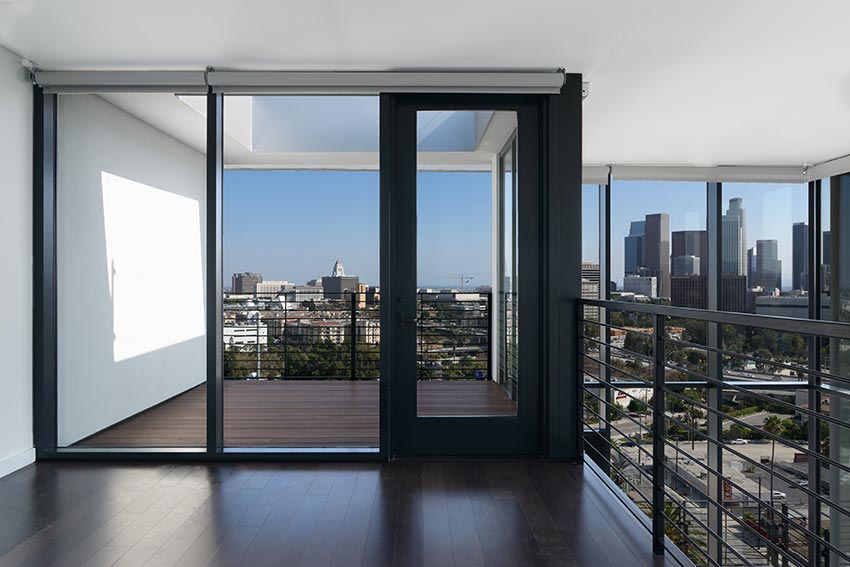
Photo: Geoff Captain
A high-performance entrance system at The Elysian in California utilizes laminated glazing for enhanced acoustics.
“In some instances, a secondary glazing element at the inside face of the mullion (e.g., jockey sash) may be required where a higher degree of acoustic performance is desired,” notes Schroter.
Williams also points out that exterior shading designs can impact acoustics (e.g., adding external projections, fins, ledges, or scrims). “These have the potential to create acoustic issues associated with wind-induced vibration and harmonics of architectural building features that can cause buildings to ‘hum’ or ‘whistle’ in certain conditions.”
Consequently, these potential risks need to be identified early and, if required, test procedures should be developed that identify causes and remedies.
Looking at the big picture, Rogan points out that glass buildings naturally reflect sound waves, so in order to improve the urban environment, it’s important to evaluate facade design as a whole. “This could involve introducing vegetation into facades, using absorbent materials, or using geometry to control reflections.”
Case Studies
Bringing a couple of examples of well-designed glass enclosures featuring curtain-wall systems, Skidmore, Owings & Merrill recently redesigned Craig Ellwood’s original 777 Aviation Boulevard building in El Segundo, California.
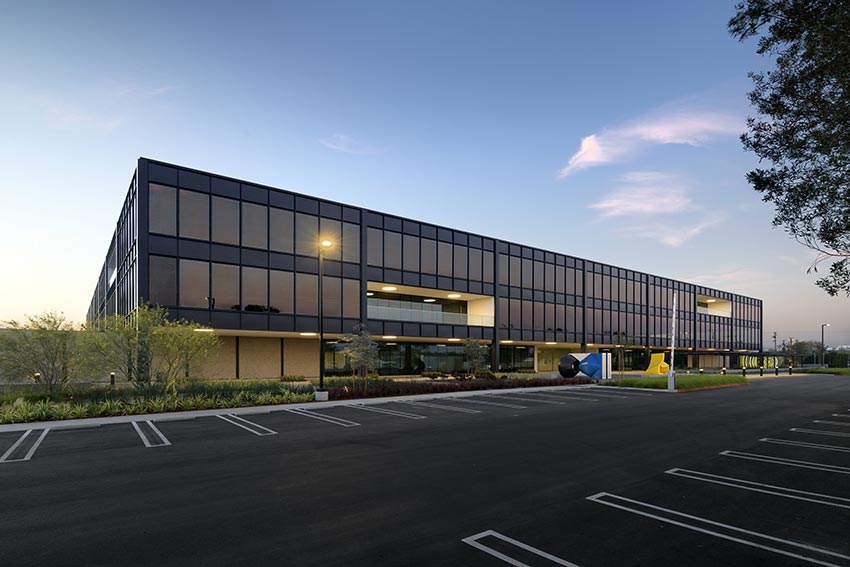
Photo: Geoff Captain
A large curtain-wall system helped transform the outdated 777 Aviation Boulevard building into a modern, daylit, multi-tenant office space.
Transforming the outdated, three-story building from a single-tenant to a multi-tenant space and infusing a modern, daylit fabric into the design, SOM specified a structural silicone-glazed curtain wall and glass entrance system. In addition, concrete shear walls were removed and a series of large-scale skylights integrated into a grand atrium.
The curtain-wall system incorporates a pressure-bar-free design, which enabled a faster installation on the first-floor facade and upper-level balcony areas. Engineered without exposed exterior vertical mullions and joint fasteners, the curtain wall delivers uninterrupted horizontal glass spans for streamlined visuals and a seamless transition to the interior. The system also utilizes a polyurethane thermal break and injection-molded thermoplastic connector that joins interior and exterior members to achieve total thermal isolation.
As for the entrance system, it was designed with ultra-narrow 1 1⁄8-inch vertical stiles and an overall system depth of just 2 1⁄2 inches. The system is unique in that door handles, including panic devices, can be installed on 1-inch insulating glass units with through-glass fittings. The result is a distinct floating-on-air, all-glass aesthetic.
“Given the performance criteria for the new fenestration and our goal of having a minimalist aesthetic, there was no other option than the entrance system we specified,” relates Susan Bartley, AIA, LEED AP, project manager, SOM Architecture, Los Angeles.
Another interesting project is Mountain Equipment Co-op’s (MEC’s) four-story, 10,219-square-meter headquarters in East Vancouver, Canada. The outdoor gear and clothing company wanted a building that would embrace its sustainable, eco-friendly brand.

Photo courtesy of C.R. Laurence
Proscenium Architecture + Interiors wood and expansive glass design for Mountain Equipment Co-op’s headquarters embraces the outdoor gear and clothing company’s sustainable, eco-friendly brand.
To accompany the extensive use of wood on the exterior and interior, Proscenium Architecture + Interiors raised the ceilings and designed the space with extensive glazing.
A high-performance, triple-glazed curtain wall occupies a large portion of the facade. The selected system features dual thermal-barrier technology, employing two fill and debridge pockets, and three thermal break points for exceptionally low U-factors. In addition, a continuous thermal spacer, injection-molded end dams, and closure plates enhance condensation resistance.
Close Coordination
As project stakeholders continue to invest in high-performance glazed facades, and tap into the building technologies that are enabling them, a highly collaborative project process is essential to make it all work.
Considering the complexity of all the assorted building enclosure components and applicable building codes, close coordination is the best approach.
Williams concludes, “To optimize the performance of the facade while maximizing daylighting and views requires a collaborative, coordinated approach between architects, facade consultants, structural engineers, manufacturers, and sustainability experts.”
